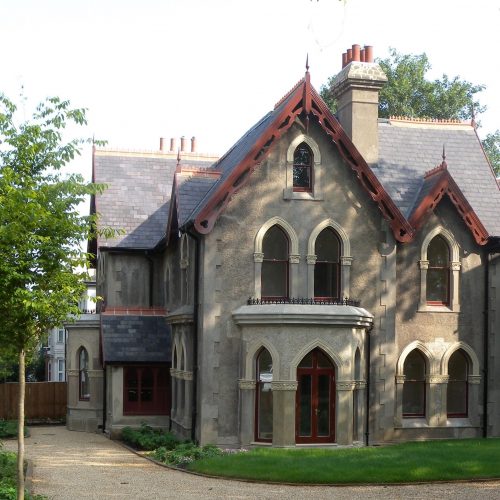The concrete house in Dulwich, London, known as “The Concrete House,” is a rare example of early concrete residential architecture in the UK. Located at 549 Lordship Lane, this Grade II* listed building, also referred to as the “Ley House,” stands out for its historical and architectural significance. Constructed in 1873, it is one of the earliest examples of concrete construction used in domestic architecture in Britain.
Architectural Significance: The house was built by Charles Drake of the Patent Concrete Building Company, using a pioneering technique involving the use of shuttered concrete. This method was innovative for its time, showcasing the possibilities of concrete as a building material. The technique involved pouring concrete into a temporary wooden framework (shuttering) to set in desired shapes and forms before the framework was removed. The method aimed at demonstrating that concrete could be a viable and economical material for building durable, fireproof houses.
The design of The Concrete House reflects the Victorian Gothic style, characterized by its pointed arch windows, steeply pitched roofs, and ornamental detailing. Despite its construction from concrete, the exterior was designed to mimic the appearance of more traditional construction materials, like stone, which was common in that period. This allowed it to blend with more conventional Victorian architectural styles prevalent in London suburbs while demonstrating the potential for modern construction techniques.


Historical Significance: The house’s construction was part of a broader movement during the Victorian era towards experimenting with new building technologies and materials. The use of concrete was seen as innovative at the time, promising cheaper, faster, and more durable construction solutions compared to traditional materials like wood and stone. The Concrete House in Dulwich represents an early architectural experiment that would eventually lead to the widespread use of concrete in all types of construction, from residential to commercial and industrial.
Preservation and Current Use: After falling into disrepair and abandonment, The Concrete House was restored in the early 2000s. The restoration work aimed to preserve the original architectural features while making the building suitable for modern use. Today, it serves as a striking example of Victorian ingenuity and the possibilities offered by concrete as a building material. The restoration process itself was challenging due to the building’s poor condition after years of neglect, but it ultimately highlighted the durability and longevity of concrete construction.
Now, the building is often used as a case study in the preservation of historic concrete buildings and serves as a residential building divided into apartments. Its status as a Grade II* listed building helps protect it from unauthorized alterations, ensuring that its historical and architectural integrity is maintained for future generations to appreciate.
Visiting or studying The Concrete House offers insights into the architectural innovations of the 19th century and serves as a reminder of how historical contexts can shape the development of construction technologies and architectural styles.

The Concrete House on Lordship Lane in Dulwich, London, indeed stands as a significant historical and architectural monument. It is particularly notable as it is believed to be the only surviving 19th-century concrete house in England built by Charles Drake of The Patent Concrete Building Company. The house was constructed in 1873, showcasing early experimentation with concrete as a building material.
Architectural and Historical Significance: Charles Drake’s pioneering use of concrete was based on Joseph Monier’s system of reinforced concrete, but without the reinforcement, which Drake believed unnecessary for domestic structures. His method involved poured concrete using a system of reusable shuttering to form the walls—a significant innovation at the time. The technology was marketed as an affordable and durable alternative to traditional brick and stone construction, and Drake’s company built several houses using this method.
The design of the house, while utilizing modern materials, adhered to the Victorian Gothic style, common in that era. This included features such as pointed arches, a steep gabled roof, and intricate detailing, which allowed it to harmoniously integrate with the traditional architectural landscape of Victorian England.
